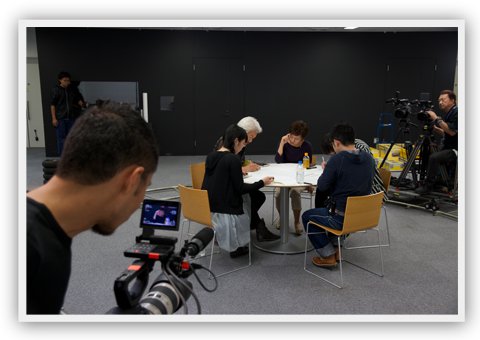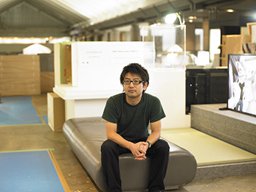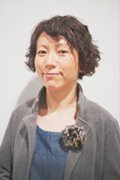Japan Pavilion at the 55th International Art Exhibition, the Venice Biennale in 2013
The Japan Foundation is delighted to announce artist Koki Tanaka’s representation of Japan at the 55th International Art Exhibition – la Biennale di Venezia, to be held from June to November, 2013, and will present the exhibition titled abstract speaking - sharing uncertainty and collective act, curated by Mika Kuraya, Chief Curator of the Department of Fine Arts, The National Museum of Modern Art, Tokyo.
The exhibition (a solo show by Koki Tanaka organized by The Japan Foundation) in the Japan Pavilion at the 55th Venice Biennale International Art Exhibition has been awarded a Special Mention.

a poem written by 5 poets at once (first attempt)
2013
HD video 68 min 30 sec
Commissioned by The Japan Foundation
Equipment support: ARTISTS' GUILD
The event report is available on Wochi Kochi Magazine.
Koki Tanaka x Mika Kuraya: Preparations Underway for the Summer! Japan Pavilion at the 55th International Art Exhibition, the Venice Biennale
Outline of exhibition at the Japan Pavilion
| Title: | abstract speaking - sharing uncertainty and collective acts |
|---|---|
| Organizer: | The Japan Foundation |
| Venue: |
The Japan Pavilion at the Giardini |
| Exhibition period: |
June 1 - November 24, 2013 |
| Curator: | Mika Kuraya, Chief Curator of the Department of Fine Arts, The National Museum of Modern Art, Tokyo |
| Exhibiting artist: | Koki Tanaka |
| With special support of: | Ishibashi Foundation |
| In cooperation with: | Daiko Electric Co., Ltd., NEC Display Solutions, Ltd. ARTISTS’GUILD |
| Japan Pavilion official HP: | http://2013.veneziabiennale-japanpavilion.jp/index.html |
About the Artist

photo:Makiko Nawa
Koki Tanaka
Born in 1975; currently lives and works in Los Angeles. In his diverse art practice spanning video, photography, site-specific installation, and interventional projects, Koki Tanaka visualizes and reveals the multiple contexts latent in the most simple of everyday acts. In his recent projects he documents the behavior unconsciously exhibited by people confronting unusual situations, e.g. a haircut given by nine hair stylists or a piano played by five pianists simultaneously, in an attempt to show an alternative side to things that we usually overlook in everyday living.
He has shown widely in and outside Japan: the Hammer Museum (Los Angeles), the Mori Art Museum (Tokyo), the Palais de Tokyo (Paris), the Taipei Biennial 2006 (Taipei), the Gwangju Biennial 2008 (Gwangju), the Asia Society (New York), the Yokohama Triennale 2011(Yokohama), the Witte de With (Rotterdam) and the Yerba Buena Center for the Arts (San Francisco). He will participate in "2013 California-Pacific Triennial" at the Orange County Museum of Art in June 2013.
Artist website: Koki Tanaka
Artist's statement
For example, each of us has within ourselves a problem. This problem is our own particular problem, and rarely does it converge with the problems of others. Problems always bring with them pain, and this pain, too, is something we cannot share with others. Things like sympathy and empathy only strengthen the boundary between those who are experiencing pain and those who are not. The vector of sympathy always travels from those who are not experiencing pain towards those who are. It cannot travel in the opposite direction. This is why we should probably explore engagement not through sympathy but through some other means.
More than a year has passed since the earthquake and tsunami, yet many problems, including the disposal of the rubble, temporary housing, and the nuclear problem, continue. In the wake of the disaster, a large number of artists as well as architects, musicians, filmmakers and so on traveled to the affected areas to undertake volunteer work, initiating actions that reflected their own creative activities. These were not short-lived responses; rather, they are ongoing. At the Japan Pavilion at this year's Venice Architecture Biennale, too, one such project will be unveiled. In the first few months after the disaster, the question on the lips of many Japanese artists was, "What can art do in response to this event?" And to this day, I think this question still lingers in the minds of many artists. While some have initiated direct actions, others have tried to respond indirectly by continuing to make art as they did before.
Well then, what exactly can I do? Actually, for me the question is rather one of thinking about what changes have occurred as a result of this event. One example is that there has arisen a social context marked by a strong willingness to share, a context that has likely not existed in Japan to date. When we look at Japanese society in terms of this context, even the most casual of actions have a completely different meaning depending on whether they occurred before or after that day. For example, on occasion we use stairs. Instead of an elevator or escalator, we use stairs. Until now we could have explained this by saying it was for our health or for the environment. But in today's Japan, it would seem that the act of "simply ascending or descending stairs" can be interpreted differently. By this I mean it might reflect an attitude of not wanting to rely on electricity (in other words, nuclear power plants), although of course this may not necessarily be the intention of the individuals concerned. When I saw large numbers of people descending the stairs at a railway station in Tokyo, it looked to me like a demonstration of some kind. Not initiating new action, but re-examining, educing, and reinterpreting the context of the actions we have undertaken to date. By doing this, it should be possible to broadly generalize particular problems in specific regions, making it impossible for anyone to ignore them.
Koki Tanaka
About the Curator

Photo: Nahoko Morimoto
Mika Kuraya
Chief Curator of the Department of Fine Arts, The National Museum of Modern Art, Tokyo, Mika Kuraya earned her MA at Chiba University. Her recent curatorial projects include: "Waiting for Video: Works from the 1960s to Today" (2009, The National Museum of Modern Art, Tokyo; co-curated with Kenjin Miwa), "Lying, Standing and Leaning" (2009, MOMAT), "Meaningful Stain" (2010, MOMAT), "On the Road" (2011, MOMAT), "Undressing Paintings: Japanese Nudes 1880-1945" (2011-2012, MOMAT). Recent critical studies include: "Where is Reiko? Kishida Ryusei's 1914-1918 Portraits" (Bulletin of the National Museum of Modern Art, Tokyo, No. 14, 2010).
Curator's statement
The installation in the Japan Pavilion will probably come across as rather desultory: pillows and flashlights, books, jars and more, placed here and there, with glimpses of photographs and video footage in between. The log pillars and stools are a partial recycling of those used for Architecture. Possible Here?, Japan's entry in the 13th Venice Biennale of Architecture in 2012. Near the entrance, staff overseeing the pavilion display go about their business at a worktable. Thus the photos and videos that would ordinarily occupy center stage as the "works" slip among the furniture and everyday items (the actual objects that appear in the photos and videos), and the staff, as items of equivalent standing. In recent years Koki Tanaka has employed a variety of methods to produce works on the relationality that arises between human beings. For these works, he either 1) sets a specific group a certain task and videos their collaboration, or 2) does something with somebody based on an idea not yet completely formed, and records this in photos and text. Nine hairdressers cutting the hair of one person, five musicians composing on a single piano, five poets writing a single poem, multiple ceramicists producing a single item of pottery?these fall under 1), video footage. In them, it is possible to see the process of people of the same occupation, employing a common language that only they understand, clashing with each other, reaching consensus, and so on (incidentally the driving force behind this process is the question of the division of space between the participants, almost a formal matter). On the other hand, belonging to 2) are what Tanaka calls "collective acts": experiments of various sorts still lacking a fixed destination, such as talking about one's own name while eating emergency rations, and walking in a large group around the nighttime streets, flashlights in hand. On 11 March 2011, Japan experienced a massive earthquake and tsunami, plus an accident at a nuclear power plant. Two years on, the situation still remains unresolved, an issue that Japanese artists continue to engage with in various forms. Architecture. Possible Here?, presenting a plan to build a house for residents of a town hit by the disaster, was one direct manifestation of this engagement. By reusing part of that exhibition site, Tanaka is attempting to address the same issue, but in a slightly more abstract fashion. For example, a haircut by 9 hairdressers at once (second attempt) (2010) was shot before the earthquake. But to those of us in Japan now, having gone through such a definitive experience, it seems a metaphor for working together to build a post-quake society. Or take the footage of people going up and down a fire escape with a book in one hand: this recalls the experience of evacuating, and has the feel of an anti-nuclear power gesture (in the sense of rejecting the consumption of electricity concomitant with escalators and elevators). Thus the tasks and acts?at first glance modest?set by Tanaka can be read in different ways according to the viewer's personal context. Having this quality of permitting many different readings, Tanaka's works will, at the geographically far removed Venice venue, provide a platform for the overlaying of yet more, new readings by people. In any case, on entering the Japan Pavilion, with the text "9478.57km" (indicating the distance from the Fukushima Daiichi Nuclear Power Plant to the Japan Pavilion) added unobtrusively next to the sign saying "GIAPPONE," even if they are unaware of it, the connections between countless viewers shouldering all sorts of contexts has already begun.
Mika Kuraya
Chief Curator of the Department of Fine Arts,
The National Museum of Modern Art, Tokyo
[Contact Us]
4-4-1 Yotsuya, Shinjuku-ku, Tokyo 160-0004
The Japan Foundation
Europe, Middle East and Africa Section
Arts and Culture Dept.
Person in charge: (Ms.) Tae Mori, (Ms.) Yoko Oyamada
Tel: 03-5369-6063 Fax: 03-5369-6038
Press Contact:
The Japan Foundation
(Att: Ms. Masako Taira)E-mail
- What We Do Top
- Arts and Cultural Exchange [Culture]
- Japanese-Language Education Overseas [Language]
- Japanese-Language Education Overseas [Language] Top
- Learn Japanese-language
- Teach Japanese-language
- Take Japanese-Language Test
- Know about Japanese-language education abroad
- The Japanese-Language Institute, Urawa
- The Japanese-Language Institute, Kansai
- Japanese-Language Programs for Foreign Specified Skilled Worker Candidates
- Japanese Language Education for Japanese Children Resident Overseas and for the Descendants of Migrants
- Archives
- Japanese Studies and Global Partnerships [Dialogue]
- JF digital collection
- Other Programs / Programs to Commemorate Exchange Year
- Awards and Prizes
- Publications
